To prevent root rot permanently, you'll need containers with multiple drainage holes and breathable materials like terra cotta or fabric grow bags. Add a layer of rocks at the bottom, and mix sand into your potting soil to improve drainage. Choose appropriately sized pots with ventilation features, and always empty water collection trays promptly. Smart multi-pot systems with moisture sensors offer advanced protection. Discover more proven strategies to keep your plants' roots healthy and thriving.
Understanding Container Drainage Systems
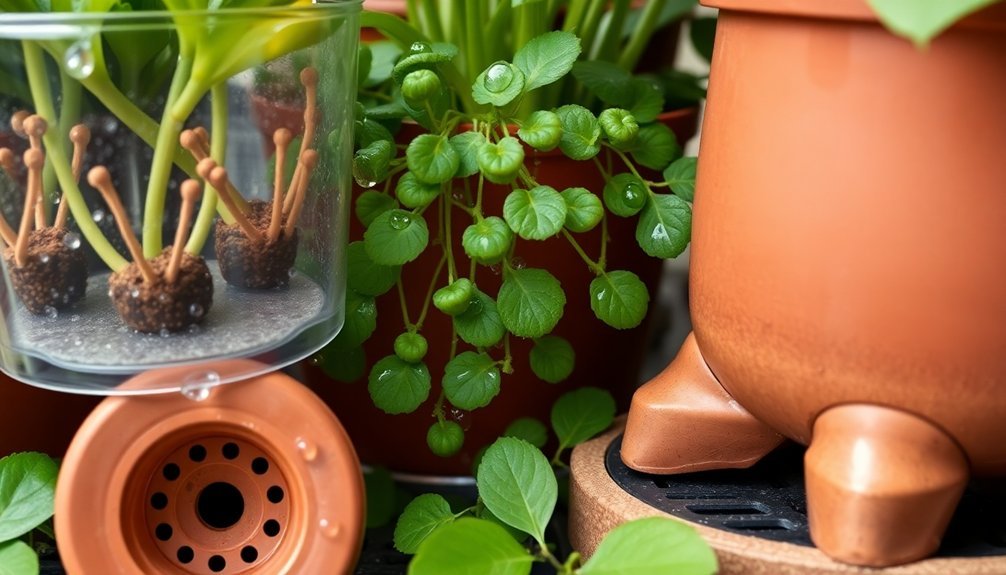
While choosing the right container for your plants is essential, understanding proper drainage systems is the key to preventing root rot. You'll need containers with multiple drainage holes to guarantee excess water flows freely, keeping your plant's roots from drowning in waterlogged soil.
Consider using terra cotta pots, which naturally absorb excess moisture and work exceptionally well for plants that don't like wet feet, like succulents and cacti.
To enhance drainage further, add a layer of rocks or gravel at the bottom of your containers. This creates additional space for water to move through and helps maintain proper soil aeration.
Don't forget to check and empty the saucers beneath your pots regularly. Even well-draining containers can't protect against root rot if water accumulates in catch basins below.
Essential Features of Root-Healthy Pots
Building on proper drainage principles, let's explore the specific features that make containers ideal for preventing root rot.
You'll want to prioritize pots with multiple drainage holes that allow excess water to escape freely.
Choose breathable materials like terra cotta, which naturally regulate moisture through evaporation – perfect for drought-tolerant plants.
When selecting your container size, remember that bigger isn't always better. An oversized pot retains too much moisture, while a cramped one restricts root growth.
For extra protection, create a drainage layer in your cache pots using rocks or sand. This prevents water from pooling at the bottom.
Don't forget to check and empty collection trays regularly to avoid standing water.
These simple yet essential features will keep your plant's root system healthy and thriving.
Best Materials for Moisture Control
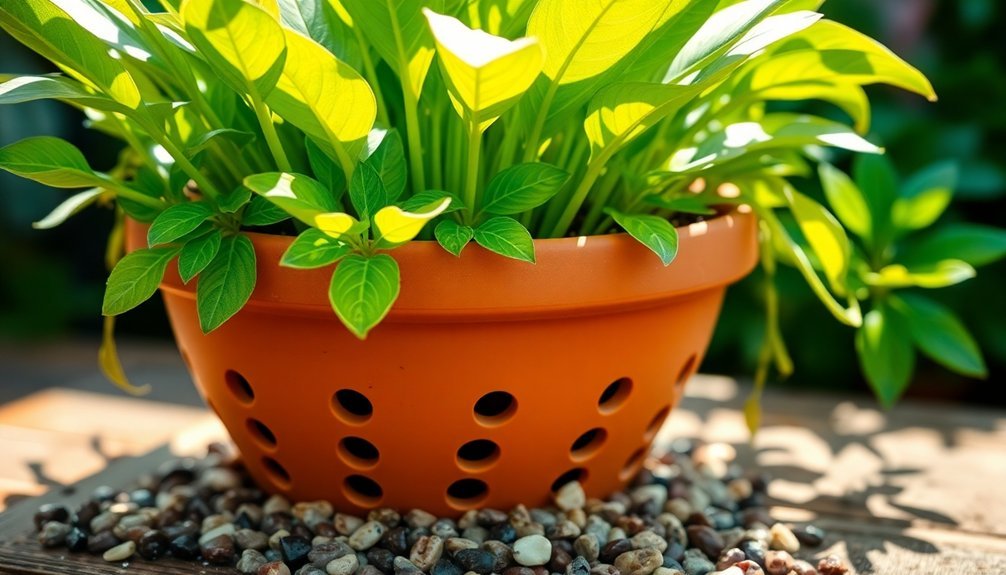
Choosing the right container material plays an essential role in managing soil moisture and preventing root rot.
For your drought-tolerant plants like succulents and cacti, you'll want terra cotta pots. Their porous nature helps excess water evaporate, keeping roots healthy.
If you're growing tropical plants, plastic containers with good drainage holes work well, as they maintain consistent moisture levels your plants need.
You've got innovative options too. Air pots provide superior oxygen flow through their multiple holes, while grow bags use breathable fabric to prevent root binding and promote drainage.
To enhance any container's performance, mix sand into your potting soil – it'll improve drainage considerably. Each material offers unique benefits, so match your container choice to your plant's specific moisture needs.
Strategic Drainage Layer Setup
To protect your plants from root rot, a well-planned drainage layer serves as your first line of defense. Start by placing rocks of varying sizes at the bottom of your container, ensuring the drainage holes remain unobstructed to allow excess water to drain freely.
Add a layer of sand above the rocks to create a natural barrier between the roots and drainage materials.
Mix your potting soil with sand to improve overall moisture control throughout the container. This combination helps prevent waterlogged conditions that can damage your plant's root system.
Don't forget to check your container's saucers or cache pots regularly – standing water is your plant's enemy. Empty any collected water promptly to maintain the effectiveness of your drainage system and keep your plant's roots healthy.
Sizing Your Container Correctly
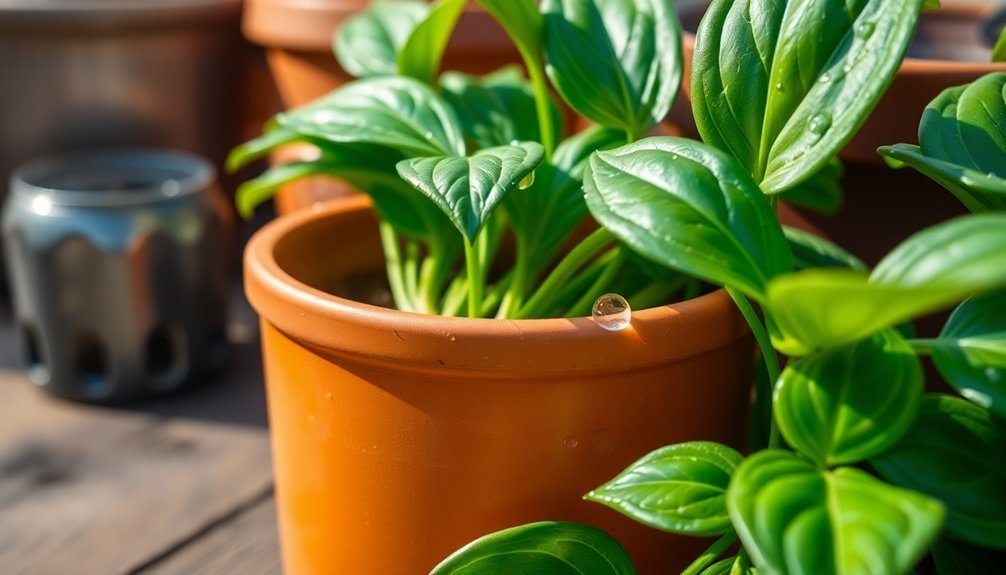
While proper drainage layers protect against excess moisture, the size of your container plays an equally important role in preventing root rot. When choosing a pot, you'll need to strike a delicate balance – too large, and your potting soil retains excess water; too small, and roots become cramped.
Select containers that are 2 inches wider in diameter than your plant's current pot, but don't go overboard. For every foot of expected plant height, use a 2-gallon container to maintain healthy root development.
Watch for signs that your plant needs a larger home, such as roots emerging from drainage holes or pushing up through the soil surface. By matching container size to your plant's mature dimensions, you'll create an environment where roots can thrive without risking waterlogged conditions.
Air-Flow Promoting Container Designs
Your best defense against root rot lies in containers with strategic air-flow design features like air pots, which use perforated walls to deliver oxygen directly to the root zone.
You'll find these containers promote natural root pruning while preventing the soggy conditions that often lead to rot.
The multiple ventilation holes create a cross-flow pattern that keeps roots healthy and actively growing rather than circling or becoming waterlogged.
Cross-Ventilation Design Features
Modern air-flow promoting containers revolutionize plant health through strategic cross-ventilation features.
You'll find these innovative designs incorporate breathable materials and smart engineering to protect your plants from root rot. Cross-ventilation guarantees your roots get maximum oxygen while preventing moisture buildup.
- Mesh-sided containers allow continuous airflow through multiple points, keeping roots healthy
- Breathable fabric walls promote natural air pruning and prevent root circling
- Multi-level drainage holes create efficient water flow paths throughout the container
- Permeable grow bags maximize oxygen exchange while maintaining ideal moisture levels
- Self-watering systems with built-in ventilation channels balance water and air distribution
These cross-ventilation features work together to create an environment where your plants' roots can thrive without the risk of rot or disease, making them essential for successful container gardening.
Root-Level Oxygen Enhancement
Building on innovative cross-ventilation features, specialized root-level oxygen enhancement takes container design to the next level.
You'll find that air pots with their strategic perforations maximize oxygen delivery directly to your plant's roots, promoting healthier growth through natural air pruning.
Choose tall, narrow containers that combine stability with ideal airflow around the root system.
When you opt for grow bags made from breathable fabric or containers with multiple drainage holes, you're giving your plants the perfect balance of oxygen and moisture control.
These designs prevent water from pooling at the bottom while ensuring continuous air circulation throughout the root zone.
This enhanced oxygen flow isn't just about better growth – it's your best defense against the fungal issues that often lead to root rot.
Smart Multi-Pot Growing Systems
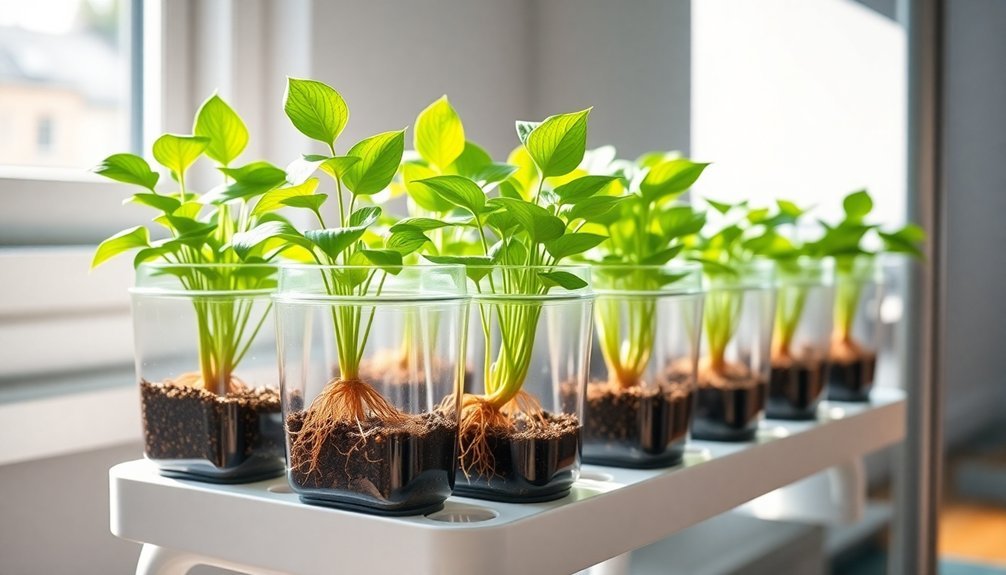
You'll maximize your growing success by stacking multiple pots in a smart system that creates essential air gaps between layers.
These modular designs let you arrange containers with precision spacing, allowing water to flow freely through each growing level while preventing moisture buildup.
The interconnected drainage system works seamlessly across all container layers, giving your plants the perfect balance of moisture and aeration they need to thrive without risking root rot.
Stack Pots For Success
Stack pots represent one of the smartest innovations in container gardening, offering a practical solution to prevent root rot while maximizing your growing space.
These multi-pot systems feature clever drainage channels that guide excess water away from your plants' roots while promoting healthy air circulation.
You'll find stack pots especially useful for their:
- Built-in moisture management that prevents waterlogged soil
- Space-efficient design that works in both indoor and outdoor settings
- Versatile arrangement options for creative gardening displays
- Breathable materials that regulate water retention naturally
- Customizable drainage levels for different plant needs
Drainage Between Growing Layers
Three key components make smart multi-pot growing systems highly effective at preventing root rot: strategically placed drainage layers, controlled water flow, and proper air circulation.
You'll find these systems are designed with multiple layers that work together to manage moisture perfectly.
The drainage layers direct excess water away from your plants' roots and into a reservoir below, while breathable materials guarantee proper airflow throughout the growing space.
This combination prevents the soggy conditions that typically lead to root rot.
Modular Container Design Benefits
Modular container designs revolutionize plant care by giving you precise control over each plant's growing conditions.
You'll find these smart systems offer built-in solutions that prevent water from pooling around your plants' roots, which is essential for preventing rot.
Here's what makes modular design so effective:
- Individual drainage control for each plant compartment
- Smart moisture sensors that alert you when it's time to water
- Customizable arrangements that adapt to your plants' needs
- Enhanced airflow circulation around root systems
- Easy expansion options as your garden grows
You'll love how these containers let you manage each plant independently while maintaining ideal moisture levels.
The modular design means you can quickly adjust your setup based on seasonal changes or plant growth patterns, keeping your garden healthy and rot-free year-round.
Container Bottom Ventilation Methods
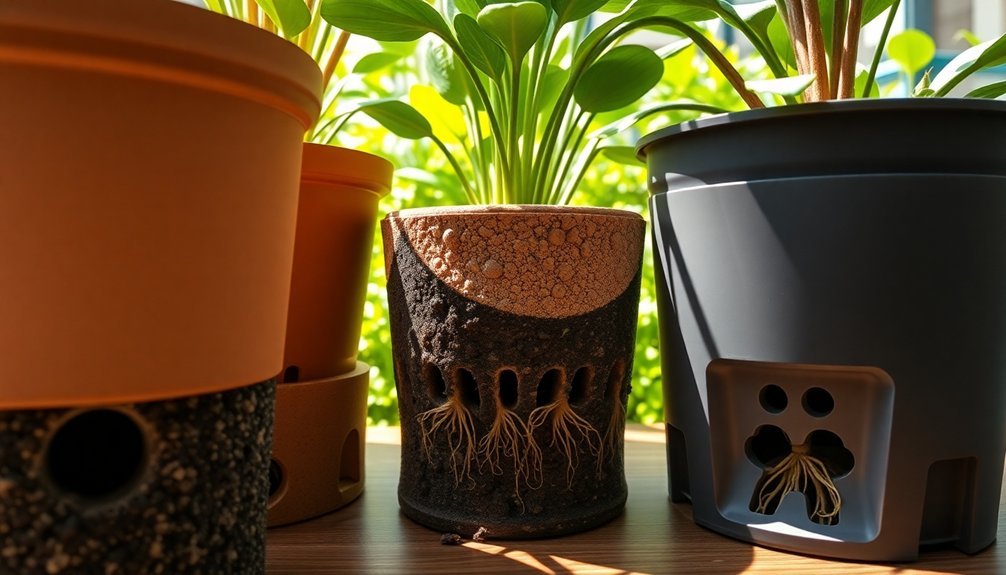
When it comes to preventing root rot, proper container ventilation starts from the bottom up. You'll want to guarantee your containers have adequate drainage holes that allow excess water to escape freely.
Choose pots with perforated designs or air pots that maximize airflow around the root zone.
Create an effective drainage layer by adding rocks or gravel at the container's base to direct water away from roots. If you prefer a more modern solution, try grow bags made from breathable fabric that naturally regulate moisture and oxygen levels.
Don't forget to empty the saucers beneath your containers regularly – standing water can quickly lead to problems.
Moisture-Wicking Material Options
Selecting the right moisture-wicking materials for your containers can dramatically improve plant health and root development.
These specialized materials help manage moisture levels and prevent root rot by promoting proper drainage and air circulation.
- Natural fiber grow bags with moisture-wicking properties encourage healthy root systems through air pruning.
- Porous clay containers allow excess water to evaporate while maintaining ideal soil moisture.
- Breathable fabric pots prevent water-logging and dry more efficiently than plastic alternatives.
- Perforated containers with built-in drainage features effectively remove excess water.
- Natural fiber containers promote ideal air circulation around root zones.
You'll find these moisture-wicking options particularly beneficial for plants that need well-drained soil conditions.
The enhanced ventilation and water management capabilities of these materials create an environment where roots can thrive without the risk of becoming waterlogged or diseased.
Self-Regulating Container Solutions
Self-regulating containers with natural aeration systems let your plants breathe through strategically placed holes and permeable materials that promote healthy root development.
You'll find these innovative containers use advanced moisture control technologies to maintain ideal water levels while preventing harmful saturation that leads to root rot.
The combination of air pruning features and temperature-regulating materials works to create an environment where your plants can thrive with minimal intervention.
Natural Aeration Systems
Natural aeration systems have revolutionized container gardening by tackling root rot at its source.
These innovative containers feature strategic perforations that maximize oxygen flow to your plants' roots, creating an environment where root rot can't thrive. By choosing pots with natural aeration, you'll give your plants the perfect balance of air and moisture they need to flourish.
- Multiple air holes promote consistent oxygen flow throughout the root zone
- Perforated designs encourage stronger, healthier root development
- Built-in ventilation prevents water from becoming stagnant
- Air pruning naturally strengthens the root system
- Enhanced airflow reduces the risk of fungal growth and disease
Moisture Control Technologies
Modern moisture control technologies have transformed container gardening by introducing smart, self-regulating solutions that prevent root rot.
You'll find containers equipped with advanced sensors that monitor soil moisture levels and dispense water only when your plants need it.
These innovative systems feature built-in wicking mechanisms that draw water from a dedicated reservoir, ensuring your plants receive consistent hydration without becoming waterlogged.
The containers' intelligent drainage design expels excess water while maintaining ideal moisture levels for healthy root development. You won't have to worry about over-watering or under-watering your plants.
Whether you're a beginner or an experienced gardener, these moisture control technologies will greatly reduce your maintenance time while promoting stronger, healthier plants.
You'll enjoy peace of mind knowing your plants are receiving exactly the right amount of water.
Root Zone Temperature Management
Managing root zone temperatures is one of the most critical factors in preventing root rot. When roots experience temperature stress, they become vulnerable to disease-causing pathogens.
You'll want to maintain temperatures between 65°F and 75°F to keep your plants thriving and resistant to root rot.
Here's what you need to do to manage root zone temperatures effectively:
- Use a soil thermometer to monitor root zone temperatures regularly
- Insulate your containers with foam materials to prevent temperature fluctuations
- Choose well-aerated soil that promotes better thermal regulation
- Apply mulch to help maintain consistent soil temperatures
- Avoid placing containers in areas with extreme temperature variations
Container Elevation Techniques
Proper elevation of your containers serves as an essential defense against root rot by promoting ideal drainage and air circulation.
Container elevation techniques range from simple to sophisticated solutions that'll help you avoid root rot in your plants.
Start by placing pot feet or risers under your containers to create airflow beneath them. You can also add a layer of rocks or gravel at the bottom to establish a drainage reservoir.
For larger containers, consider installing wheels or casters, making it easier to move them when water needs draining.
Plant stands and shelves offer another effective solution, keeping your containers raised and drainage holes unobstructed.
If you're planning a bigger garden setup, elevated beds with built-in drainage systems provide excellent conditions for healthy root development.
Frequently Asked Questions
What Is the Best Way to Prevent Root Rot?
You'll prevent root rot by using containers with drainage holes, choosing proper pot sizes, adding well-draining soil mix, monitoring moisture levels carefully, and removing standing water from saucers after each watering session.
Will Repotting Stop Root Rot?
Yes, repotting can stop root rot if you remove infected roots, use fresh well-draining soil, and choose a properly sized container. You'll need to maintain appropriate watering habits afterward to prevent recurrence.
How to Prevent Root Rot in Pots Without Drainage Holes?
You'll need to add a layer of gravel at the bottom, use well-draining potting mix, and water sparingly. Monitor soil moisture carefully and consider using cache pots with nursery containers for better drainage.
What Is the #1 Cause of Root Rot?
You'll find that overwatering is the #1 cause of root rot. When you water too frequently, your soil becomes saturated, creating perfect conditions for harmful fungi to thrive and damage your plant's roots.
In Summary
You've now got all the tools to prevent root rot from destroying your plants. By selecting containers with proper drainage, using the right materials, and implementing smart watering strategies, you'll keep roots healthy and thriving. Remember, it's not just about the pot – it's about creating an entire system that manages moisture effectively. Put these techniques into practice, and you'll never battle root rot again.

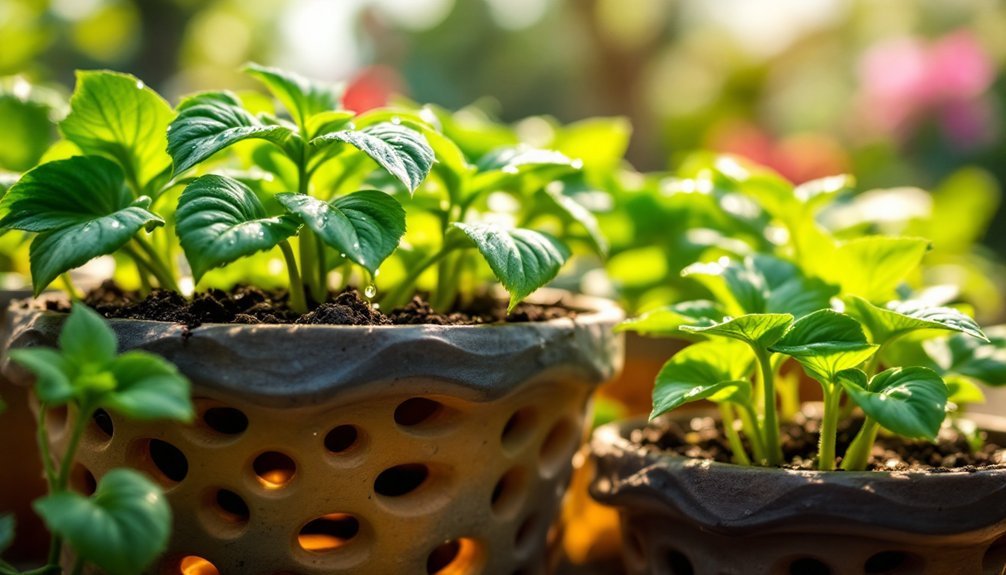



Leave a Reply